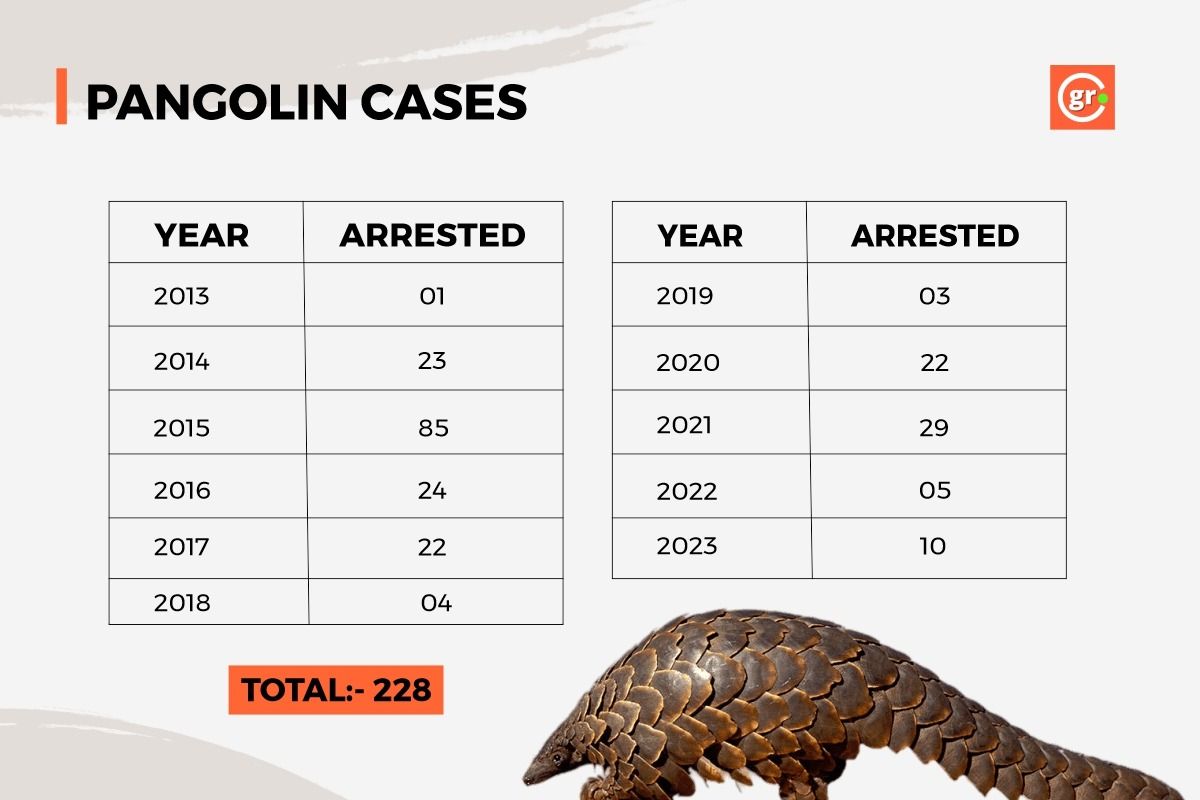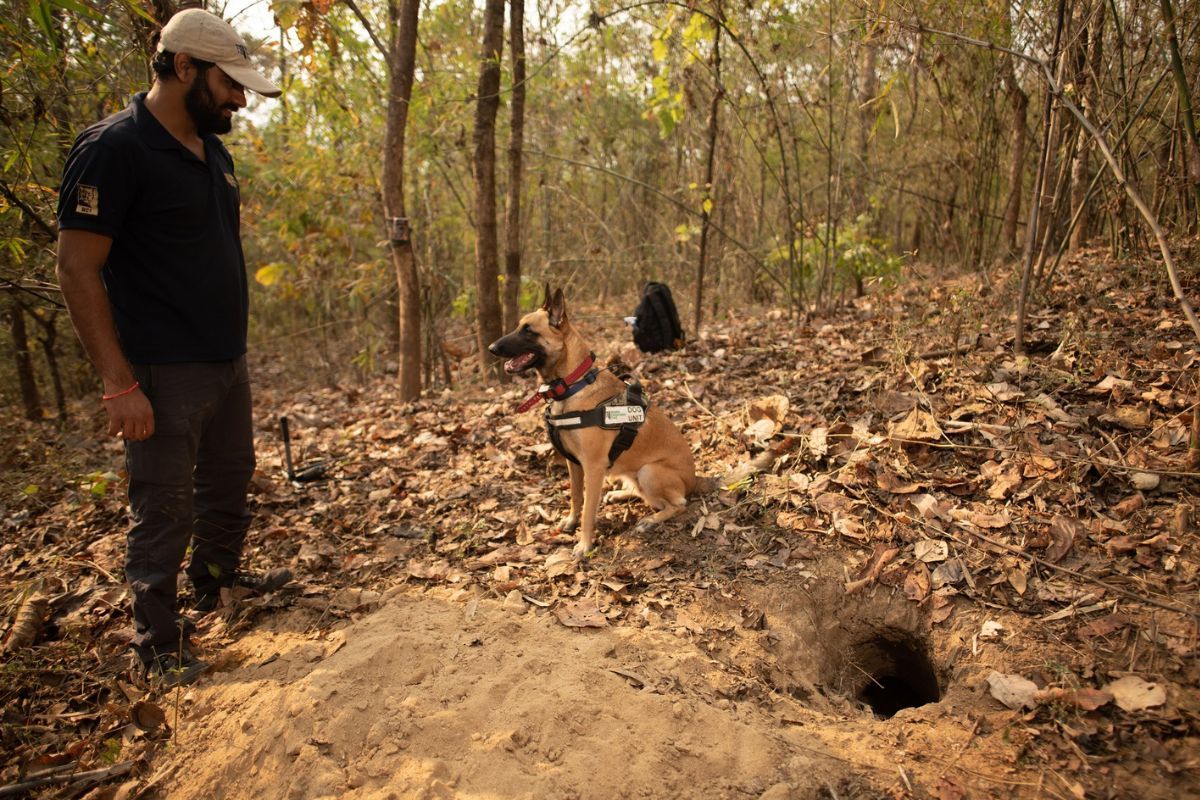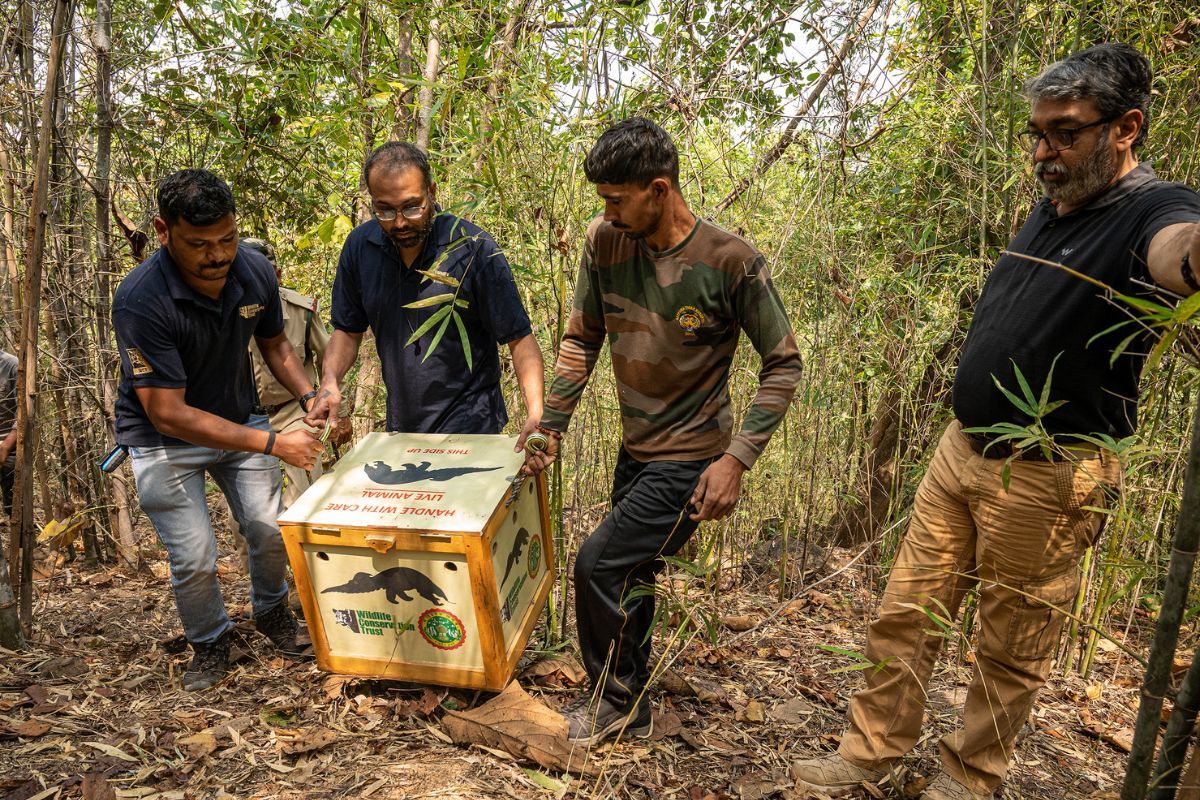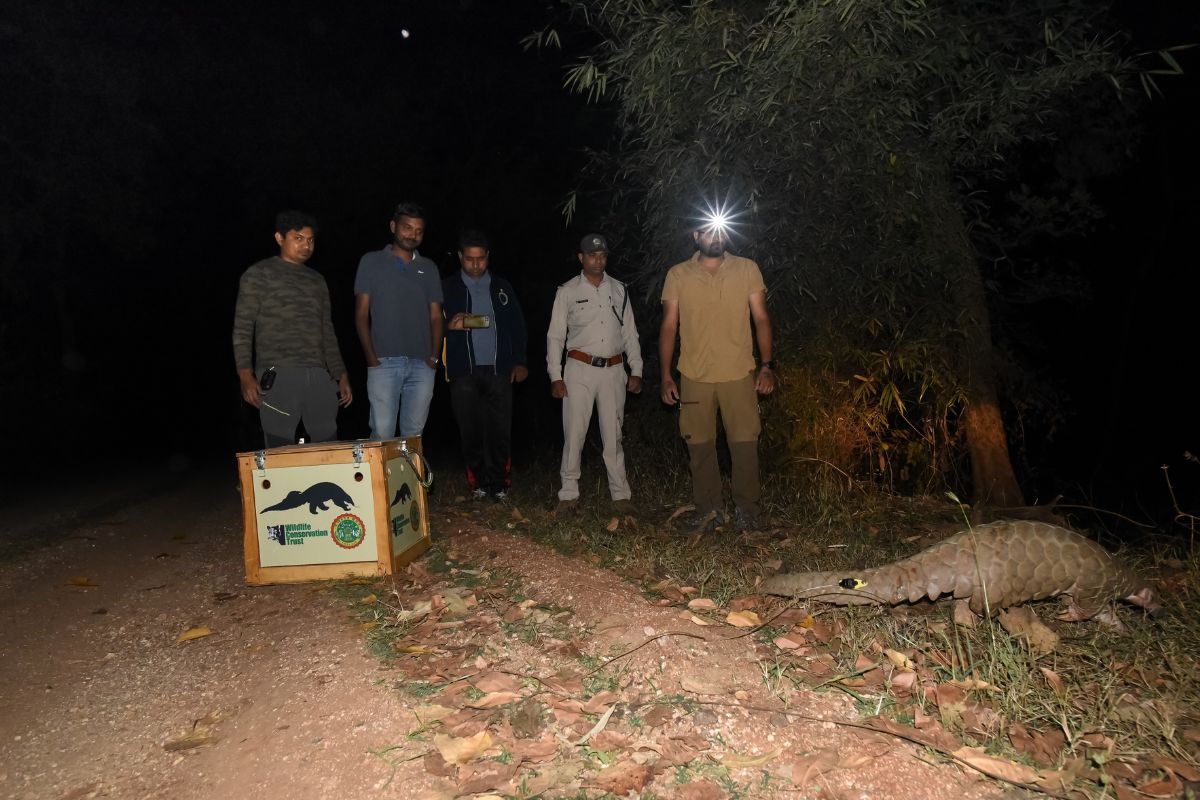The pangolin, a unique and elusive mammal, is edging toward extinction. Listed as endangered by the IUCN Red List of Threatened Species, The scaly anteaters face a precarious future, threatened by illegal trade, lack of public awareness, and their natural reclusiveness. In India, the Wildlife Conservation Trust (WCT), in partnership with the Madhya Pradesh Forest Department, has launched a conservation initiative to protect the species. Ground Report delves deeper into understanding the conservation project, its problems, and the way ahead.
Protecting Pangolin
There are 8 species of pangolins in the world. India is also home to two of these species, the Indian pangolin (Manis crassicaudata) and the Chinese pangolin (Manis pentadactyla). Of these, the Indian pangolin is found in the plains of the Indian subcontinent and the Chinese pangolin in the mountainous regions.
Pangolins don’t have teeth, but they do have a long, sticky tongue that helps them eat foods such as ants and termites. Pangolins also have long tails that help them climb trees. In addition to all this, the body of the pangolin also has sharp scales made of keratin, which makes it a unique organism.
Pangolins usually emerge at night and build deep burrows for their habitat. Their nocturnal instincts and ability to fold itself into a round ball-like shape give it protection from wild predators.

Despite their protected status under India’s Wildlife Protection Act, pangolins are at risk of extinction due to low public awareness and illegal trafficking. Madhya Pradesh is one of the few Indian states besides Maharashtra and West Bengal to develop a pangolin conservation action plan, focusing on raising awareness and protecting pangolins from illegal trade.
The Wildlife Conservation Trust (WCT), A Mumbai-based not-for-profit organisation has been working with the Madhya Pradesh Forest Department for pangolin conservation since 2019. Dr Anish Andheria, President and CEO of WCT, shares that the project expands to two forest areas of Madhya Pradesh– Pench and Satpura.
Andheria explains,
“Whenever the forest department intercepts an illegal pangolin smuggling case and rescues a live pangolin, they notify the WCT team. Our team then steps in to rehabilitate the pangolin.”
He adds,
“The condition of these pangolins is often dire. Poachers keep them in distressing conditions, and sometimes they go days without food. Our first priority is to treat and stabilize them. Once they recover, we tag them and release them back into the wild, where they are continuously monitored.”
Till date, 14 pangolins have been rehabilitated in the Pench and Satpura tiger reserves.
Why are pangolins smuggled?
Pangolins are smuggled across many parts of the world, sometimes alive and sometimes for their keratin-rich scales. Aditya Joshi a scientist with WCT and program head of the pangolin conservation project, argues that the reasons behind this are rooted in myth rather than science.
“Pangolins are used in traditional Chinese medicine, and pangolin meat is regarded as a luxury in Vietnam. However, there is no scientific evidence of any medicinal benefit from pangolins. These beliefs are myths and superstitions, which have driven the illegal trade, putting the species’ survival at risk,” Joshi explains.
Pench Tiger Reserve Deputy Director Rajneesh highlights similar concerns, drawing parallels to the smuggling of sand boas, which is also fueled by unfounded and unscientific beliefs.
“There is no evidence that pangolins or their scales can cure any disease or serve as a drug. The supposed benefits of pangolin products are mere conjectures,” he notes.
Rajneesh further states that pangolin smuggling became more noticeable around 2008-2010, peaking in 2015-2016.

In operations led by the Tiger Strike Force, we initially seized pangolins along with other contraband. Gradually, the forest department began tackling the issue more effectively. Significant seizures and arrests were made, and the department identified a smuggling route that spanned from Chhattisgarh through Andhra Pradesh, Bengal, and Mizoram, eventually leading to Burma.
The forest department has since intensified its efforts to curb pangolin smuggling in the state. Today, we can confidently say that organized pangolin smuggling has been dismantled, and the trade networks in Madhya Pradesh have been effectively broken.
Raju Rajput, an officer with the forest department, shared case details on pangolin-related incidents since February 2013. A total of 24 cases have been registered in the state since then, resulting in the arrest of 228 individuals. The peak period for pangolin-related arrests was between 2015 and 2016, with the most recent case reported in August 2023.

Conservation Challenges
Andheria explains that conserving pangolins comes with many unique challenges. One of these is the animal’s small size, which complicates the process of tagging. Tags are attached by drilling into the pangolin’s keratin scales, but this is more difficult than tagging larger animals like lions or elephants. Smaller animals require smaller tags, which means a shorter battery life. Pangolin tags often fall off or get lost in their burrows.
Pangolins are fitted with two types of tags: satellite and VHF (Very High Frequency) radio tags. Satellite tags rely on satellite signals to provide a full range of movement data once contact is established. VHF radio tags, in contrast, offer real-time location tracking. These tags, which typically weigh around 30 grams, allow researchers to monitor pangolins’ movements.
Monitoring, however, is tricky due to the tags’ limited range. The team must maintain enough distance so as not to disturb the pangolin while staying close enough to remain within the tag’s range. They track where the pangolins dig their burrows and map these locations. Camera traps are set up at burrow entrances for continuous observation. To aid in tracking, conservation teams sometimes deploy sniffer dogs to locate pangolins and their burrows.
Pangolins’ nocturnal habits add another layer of difficulty. Conservation efforts often take place at night, with teams of researchers, and forest guards working together to protect these elusive animals.

Results so far
Aditya Joshi, explains that efforts have been made to conserve pangolins in Africa as well, but with limited success—nearly 60 per cent of rescued pangolins there did not survive. He attributes this to a lack of understanding about pangolin habitats.
“Pangolins are incredibly shy animals that prefer low-density, undisturbed areas. If they sense a human presence, they often refuse to come out. They have specific dietary needs, feeding only on ants and termites, and move very slowly. All these factors are crucial for their protection. For effective conservation, pangolins need areas where food sources are abundant and water is nearby—conditions that allow them to thrive naturally,” he explains.
Jhosi explains that over the past five years, 14 pangolins have been protected across two forest areas in Madhya Pradesh. Among these, 10 are female and 4 are male. Remarkably, no pangolins have died since the conservation efforts began, and five pangolin births have occurred, underscoring the species’ naturally slow breeding rate. Female pangolins typically give birth to just one offspring at a time.
Joshi adds,
“The fact that the pangolins under our care have successfully bred is a positive sign that our conservation efforts are on the right track.”
Rajneesh Singh, Deputy Director of Pench Tiger Reserve and part of the pangolin conservation project highlights the lack of awareness about pangolins and their conservation importance in India. He recalls a 2019 awareness event in a Bhopal mall where visitors misunderstood the initiative, asking, “If there is no snow in Madhya Pradesh, how are we saving the penguin?”
Rajneesh adds, “During seizures by the Tiger Strike Force, we have recovered live pangolins and pangolin scales. The pangolin is a shy, nocturnal animal, so information on its behaviour and diet is limited.”
This conservation project aims to gather data on pangolin habitats, diets, and habits, providing critical insights to enhance protective measures.

Highlighting the importance of pangolin in our ecosystem, Aditya Joshi emphasized the importance of conserving all life on Earth, particularly highlighting the pangolin’s ecological role.
“Pangolins are habitat creators. Their unique burrows provide shelter for other creatures, like pythons. Additionally, they consume ants and termites, maintaining a balance in local food chains. Pangolin survival is crucial for ecological stability,” Joshi explained.
Many conservationists have pointed out that these species are often smuggled out of protected areas. “If the local communities living around the forests understand the importance of these animals to our ecology, we can help minimize rampant smuggling,” they say.
A senior official from the Madhya Pradesh forest department, speaking anonymously, expressed concern over the government’s commitment to wildlife conservation.
“While tiger conservation receives considerable publicity, budgets per unit for tiger projects are being reduced. Pangolin conservation could be achieved relatively easily if clear policies and intentions were in place,” the official noted.
The figures provided only reflect pangolins within protected areas. Many more pangolins live outside these zones, where they face significant poaching risks. Furthermore, public awareness about pangolins remains limited. These factors underscore the urgent need for targeted policy efforts to support pangolin conservation.
Support us to keep independent environmental journalism alive in India.
Keep Reading
Govt shelves elephant census, population drops 20% in 5 years
Wildlife SOS mourns passing of Suzy, 74, oldest rescued Elephant
Asian Elephants display complex mourning rituals similar to humans: study
Asian Elephant populations threatened by rapid ecosystem decline
Follow Ground Report on X, Instagram and Facebook for environmental and underreported stories from the margins. Give us feedback on our email id greport2018@gmail.com.
Don’t forget to Subscribe to our weekly newsletter, Join our community on WhatsApp, and Follow our YouTube Channel for video stories.







